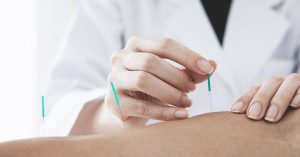 Acupuncture relieves pain (1), balances musculo-skeletal chains, and regulates physiological systems. It is done by inserting fine, sterile needles.
Acupuncture relieves pain (1), balances musculo-skeletal chains, and regulates physiological systems. It is done by inserting fine, sterile needles.
Biomedical explanations of how it works include inhibition of nervous feedback, stimulation of hormone release, and transmission through the myofascia acting as a whole body organ that is interlinked with the rest of the body. Chinese medicine uses a model of qi flow in the body that can be regulated by acupuncture and Chinese medicine acupuncturists use this model to diagnose and treat disease. Acupuncture works regardless of the model used to explain it. It has been adopted by physiotherapists, myotherapists and other physical therapists as they can see how effectively it treats musculo-skeletal pain and its causes. Many GP’s also train in acupuncture so they can use it to treat a variety of conditions. Chinese medicine acupuncturists are pleased that other healthcare professionals recognise the usefulness of acupuncture, but feel that the 500 plus hours of supervised clinical training we must do to qualify for registration make us the best healthcare professionals to see for acupuncture treatment. Some other healthcare professionals learn acupuncture in a few days, and call it dry-needling because they are not qualified acupuncturists.
Does it hurt?
Some fear acupuncture for the sting of the hypodermic needle used for injection and sampling, but acupuncture needles are so fine that many of them can fit inside a syringe needle. Acupuncturists seek a diffuse, numb, ache around the needle which they can skilfully moderate. There is sometimes a slight, momentary sharpness as the needle passes through the skin, but most patients don’t feel this.
1. Andrew J. Vickers, Emily A. Vertosick, George Lewith, Claudia M. Witt, Klaus Linde. Journal of Pain 19;5,p455-474. Acupuncture for Chronic Pain: Update of an Individual Patient Data Meta-Analysis.
retrieved 23/4/20